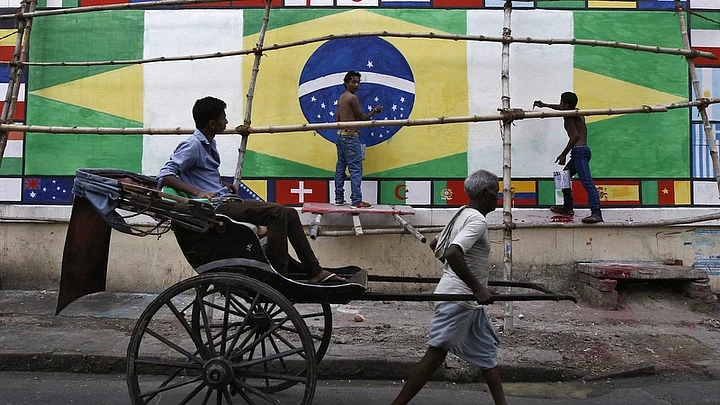Now that the finalists are known, Spain’s Barcelona and Italy’s Juventus, my son and I will stay up all night to watch the finals of Europe’s football Champions League on June 6.
Both of us will root for Barca. And our hero, Lionel Messi, and his striking partners Neymar Jr and Luis Suarez. Why? Maybe it’s the whole thing about Barcelona from Catalonia, rebels in Spain, and arch rival of Real Madrid, a club once patronised by the dictator, Franco. Rebels are attractive, more so when they play great football.
Football, Mon Amour!
But it was not always thus. Growing up in Calcutta in the 1970s, our fierce football rivalries were, well, literally painted on walls.
Graffiti of the political sort was always common in the city: red hammers, sickles, stars; the various Congress symbols, were ubiquitous.
But often, especially at the start of ‘the season’ the facades of entire houses would be re-painted maroon-green, or red-yellow — the colours, respectively, of Mohun Bagan and East Bengal.
Not only were these clubs arch rivals on the field, but also represented a simmering ethnic rivalry, with often violent undertones.
You see, Mohun Bagan, the oldest ‘native’ club formed in 1889, represented ghotis, the natives of West Bengal. East Bengal, formed a few years later, belonged to bangals, natives from the east, who had migrated to the west for various reasons.
The former derided bangals for being country bumpkins; the latter repaid the compliment by calling ghotis overweening snobs. The derbies were played with passion. Later, the outpouring of triumph and gloom after the results would lead to large-scale fan violence.
This is not uncommon in football, a game known as much for its beauty as its tribalism, the world over.
Winds of Change
Alas, all this changed after 1982, the first time a FIFA World Cup was telecast live. Both ghoti and bangal watched with eyes popping, what the top-class global game was all about.
It sank in quickly how futile and petty our fierce rivalries had been. Of course Bagan and Bengal continued, but suddenly, a new sort of rivalry — and graffiti emerged.
Suddenly, slum-dweller and bhadralok alike, were divided between the canary-yellow-and-emerald of Brazil and the sky-blue-and-white of Argentina. After the 1986 Cup, where Argentina, led by the near-supernatural Diego Maradona lifted the Cup, giant images of him appeared all over Calcutta’s facades.
Unsurprisingly, everyone supported the Latin Americans; you could scour the city and not find a single follower of Italy which won the 1982 Cup; or West Germany that lost that final 1-3. Or even after 1990, when Germany won, who cared about them? Instead, we wept with Maradona, who’s Argentina lost the finals.
It must have been all those revolutions: Castro, Che, Guantanamera, Third World solidarity and all that. In our collective imagination, Italy and Germany were villains — and they played ugly football.
A Newfangled Present?
Yet a generation later, much has changed, and much is due to television, which first started streaming the English Premier League live, and now covers the Spanish, German and Italian leagues as well. Our kids have grown up on this diet and not on our old, regional, pre-TV loyalties.
After all, my son rooted for Spain during the 2010 Cup which it won, and in 2014, which it lost, miserably, in the early rounds.
During the 2014 Cup final game, a fascinating, tactical match fought closely between Argentina and Germany, both of us were rooting for the former: after all, it was led by our hero Leo Messi. Germany won, 1-0, and our hearts bled for Argentina and Leo.
But on June 6, as two generations of us will watch the Barcelona-Juventus final, in New Delhi, I feel some things have, perhaps, remained constant across our eras. From the days when Calcutta was painted over with Argentina-Brazil colours and Maradona loomed over the traffic; to now, when we root for the same European team.
After all Barcelona’s deadly attacking trio are all Latin. Luis Suarez, the newest among them, is from Uruguay. Neymar Jr is Brazilian. And of course, Leo Messi — the greatest modern footballer and Maradona’s successor — is from Argentina.
And before the 2014 World Cup, Calcutta’s football graffiti featured Messi and Neymar in their national colours.
